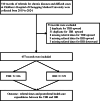Construction and Evaluation of the Bidirectional Referral System in Internet Hospital: Case Study of Children's Hospital in Western China
- PMID: 40690599
- PMCID: PMC12303232
- DOI: 10.2196/69765
Construction and Evaluation of the Bidirectional Referral System in Internet Hospital: Case Study of Children's Hospital in Western China
Abstract
Background: The World Health Organization (WHO) emphasizes internet IT as pivotal for optimizing health care system efficiency. Traditional bidirectional referral (TBR) systems, hindered by manual processes and information asymmetry, face challenges in pediatric care. While internet bidirectional referral (IBR) systems demonstrate effectiveness compared to TBR methods, comparative performance analyses remain remarkably scarce.
Objective: This study aims to develop a systematic and standardized bidirectional referral framework for internet hospitals and analyze the differences in core referral indicators of referral time and postreferral medical expenses between TBR (2019-2021) and IBR (2022-2024) at the Children's Hospital of Chongqing Medical University.
Methods: This study is a retrospective cohort study that includes patients aged 0-18 years with chronic diseases and complex cases in both TBR and IBR periods, while excluding emergency cases. We compared the differences between TBR and IBR across multiple dimensions, including demographic characteristics, downward-to-upward transfer ratio, core indicators (referral times and postreferral medical expenses) and referred diseases, and medical departments.
Results: This study included a total of 457 referral cases, with 106 in the TBR group (79 upward and 27 downward, resulting in a downward-to-upward referral ratio of 34.18%) and 351 in the IBR group (329 upward and 22 downward, resulting in a downward-to-upward referral ratio of 6.69%). Compared with the TBR group, the median referral time in the IBR group was significantly shorter (0.90 d vs 2.51 d; P<.001), and the median postreferral medical expenses were lower (¥13,091.16 [US $1822.34] vs ¥8380.59 [US $1166.61]; P=.01). We observed that in both groups, the respiratory department consistently ranked as the top specialty for upward referrals, with pneumonia emerging as the most prevalent diagnosis for such transfers.
Conclusions: In pediatric care, the IBR system improved referral efficiency and reduced postreferral medical expenses compared with TBR methods, but there is still a low downward referral rate. While the IBR system shows promise and merits widespread adoption, further validation across diverse medical institutions and broader populations is necessary.
Keywords: children; internet bidirectional referral; internet hospital; referral efficiency; traditional bidirectional referrals.
© Qinling Li, Yunzhen Deng, Xiangdong Yin, Yingliang Li, Lan Hu, Bin Yang. Originally published in the Journal of Medical Internet Research (https://www.jmir.org).
Conflict of interest statement
Figures
Similar articles
-
Signs and symptoms to determine if a patient presenting in primary care or hospital outpatient settings has COVID-19.Cochrane Database Syst Rev. 2022 May 20;5(5):CD013665. doi: 10.1002/14651858.CD013665.pub3. Cochrane Database Syst Rev. 2022. PMID: 35593186 Free PMC article.
-
Development and implementation of an "Internet " integrated service model for antepartum, intrapartum, and postpartum care in maternal and child specialty hospitals: A randomized controlled trial.Digit Health. 2025 Jul 20;11:20552076251357657. doi: 10.1177/20552076251357657. eCollection 2025 Jan-Dec. Digit Health. 2025. PMID: 40693253 Free PMC article.
-
Comprehensive care programmes for children with medical complexity.Cochrane Database Syst Rev. 2024 May 30;5(5):CD013329. doi: 10.1002/14651858.CD013329.pub2. Cochrane Database Syst Rev. 2024. PMID: 38813833 Free PMC article.
-
Melatonin versus midazolam in the premedication of anxious children attending for elective surgery under general anaesthesia: the MAGIC non-inferiority RCT.Health Technol Assess. 2025 Jul;29(29):1-25. doi: 10.3310/CWKF1987. Health Technol Assess. 2025. PMID: 40622250 Free PMC article. Clinical Trial.
-
Home treatment for mental health problems: a systematic review.Health Technol Assess. 2001;5(15):1-139. doi: 10.3310/hta5150. Health Technol Assess. 2001. PMID: 11532236
References
-
- Global strategy on digital health 2020-2025. World Health Organization. [07-05-2025]. https://www.who.int/publications/i/item/9789240020924 URL. Accessed.
-
- The general office of the central committee of the communist party of China and the general office of the state council issued “opinions on further improving the medical and health service system”. China Government. [31-03-2025]. https://www.gov.cn/zhengce/2023-03/23/content_5748063.htm URL. Accessed.
-
- Ofosu B, Ofori D, Ntumy M, et al. Assessing the functionality of an emergency obstetric referral system and continuum of care among public healthcare facilities in a low resource setting: an application of process mapping approach. BMC Health Serv Res. 2021 Apr 29;21(1):402. doi: 10.1186/s12913-021-06402-7. doi. Medline. - DOI - PMC - PubMed
-
- Guan Z, Chen H, Zhao N, et al. Pricing and capability planning of the referral system considering medical quality and delay-sensitive patients—based on the Chinese Medical System. JMF. 2020;10(1):96–131. doi: 10.4236/jmf.2020.101008. doi. - DOI
MeSH terms
LinkOut - more resources
Full Text Sources



